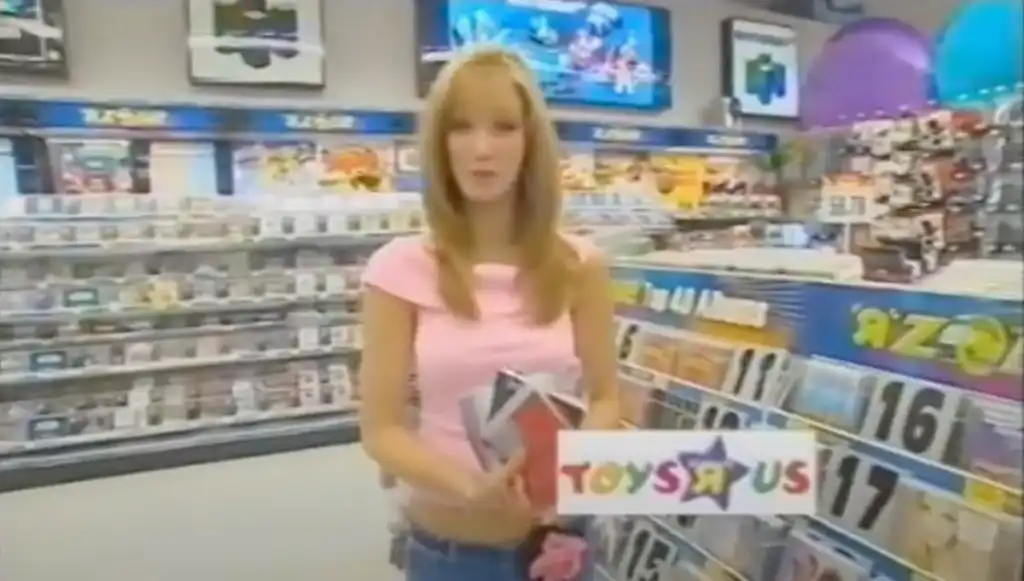Before shopping centres devolved into capitalist wastelands packed with bustling feet and shoppers set on smash-and-grab missions, they were more experimental, magical places – realms where kids could roam, play the latest games, sit down with an old PC, or jump into a playground ball pit. While that’s looking at the shops with rose-tinted nostalgia, it’s hard to deny the early 2000s were influenced by the shiny new concept of ‘experiential’ retail.
Buoyed by the idea that the shops could be fun, Australian stores like Toys ‘R’ Us, Harvey Norman and Gateway opened their doors to hordes of children in this era, providing unique and memorable experiences to every young and impressionable visitor.
Both Gateway and Harvey Norman allowed kids to hop onto then-modern PCs, running programs like Kid Pix, Putt-Putt, Spy Fox and Carmen Sandiego to teach about the wonders of gaming, and the benefits of edutainment. Not only was it a clever marketing ploy – kids who enjoyed these games would go on to badger parents to purchase the games, or a new computer – it also allowed many to experience PC or console gaming for the first time.
Computers and consoles were expensive in the 1990s and early 2000s. The original PlayStation, for example, entered the market in Australia at AU $699.95 – nearly double the cost of modern consoles, based on inflation. PCs cost thousands more. If you got lucky, a parent might have had a home computer for work but even then, you might have been banned from playing games on it.
Having easily accessible PCs in shopping centres transformed the entire experience of even going to the shops growing up. A trip to a homemaker’s centre that might have been boring was suddenly a big and marvellous adventure. While your parents roamed the aisles looking at the latest video camera, or a replacement set of drawers, you could jump into missions searching for the wily Carmen, or save the zoo with Putt-Putt.
Toys ‘R’ Us went one step further, creating a mecca for young kids intrigued by the worlds of gaming and pop culture. The Toys ‘R’ Us in Moore Park, Sydney was a magical escape for kids of my era. While it no longer exists, the memories of walking down stuffed aisles and visiting its cube-like entertainment section remain vivid.

To kids, money is no object – rather, they have no idea it exists, or the burden of how it functions. Money is used to buy toys, clothes, and other fun goods. That’s about where their understanding stops. As a child, a trip to the shops was glorious for its potential. You could browse aisles filled the games, and with no concept of value for money, imagine a future where every toy and game on the shelf was yours.
In the entertainment section of Toys ‘R’ Us, Moore Park in Sydney – that could almost be a reality. This segment of the store was dedicated solely to video games, CDs, videos, and Tamagotchis. The walls were lined with new releases, and playable PlayStation and
Sure, that often meant older, rougher boys would often move you on – but being forced to surrender the controller never felt like an impost. Even if you weren’t playing for yourself, you could watch – and kids often did, crowded around the tiny Toys ‘R’ Us monitor watching Crash Bandicoot 2 with wide-open eyes. It didn’t matter if you were surrounded by strangers, every child would be glued by the latest games, and the excitement of playing a new console.
And when you weren’t dragging your fingers down the new release section, making hell for whatever poor staffer had to clean up after the hordes, you could wander the nearby entertainment aisles examining new Digimon digivices, or searching for Delta Goodrem’s Innocent Eyes on the music charts.
It was a purer time, and one that influenced an entire generation of children. While actually purchasing a game required a hefty dose of begging around a birthday or Christmas, even being able to experience video games – for fleeting moments – was a real and memorable joy.
It was the discovery of gaming through retail experiences that buoyed my love for the medium, and while I likely would have gravitated towards the world of gaming regardless, it’s impossible to overstate how influential the Toys ‘R’ Us shopping experience was on my childhood – for myself, for my siblings, and for many of my friends.
I wouldn’t be here, many years into a career writing about video games, without such a formative experience.
With Toys ‘R’ Us planning to relaunch physical stalls within Macy’s in the United States – not in Australia, as of writing – it’s the perfect moment to remember how pioneering the store franchise was, and how it shaped so many childhoods. While the experience won’t be the same in the modern era – kids now have so much free access to the internet, and gaming on home consoles or PCs, that it can never be as ‘special’ as it once was – there’s hope that some element of the original magic can be recaptured.
Toys ‘R’ Us was a place where kids could explore freely, where the world felt like it had no limitations, and gaming was accessible for everyone. Going to the shops as an adult, browsing the shelves of EB Games or JB Hi-Fi for new releases, knowing you’ve got responsibilities waiting at home, just isn’t the same.
Even tinted by nostalgia, the memories of going shopping for video games in the early 2000s will never be matched – and we should all thank Toys ‘R’ Us for that.





